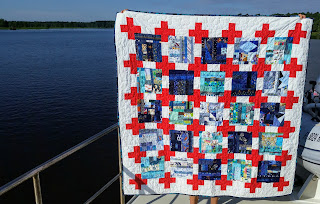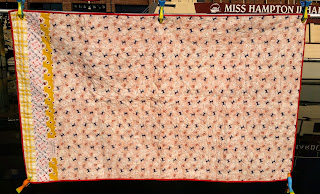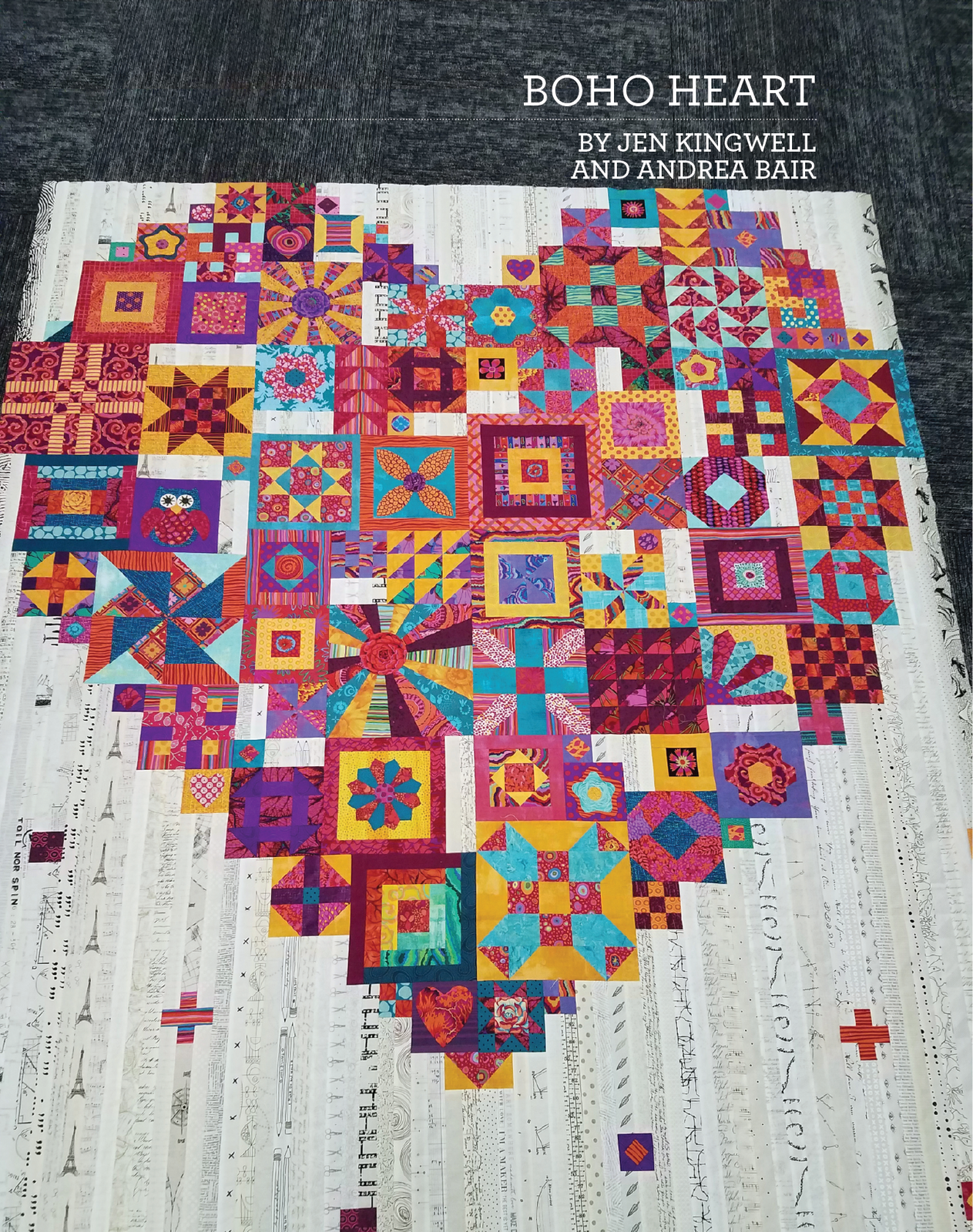Today I'm going to answer some of the great questions you asked in response to my video tour. Let's get started!
Tina asked: I am curious how you made the connection with Kat and Covered in Love?
 |
One of my first CiL block drives
|
I started making block drive blocks for Kat back in 2015, I think. Like many quilt bloggers, she responded to my comments on her posts and we just sort of struck up a friendship via email. I wrote a few guest posts for her blog when she was super busy with her nursing work. When she took the legal steps to make Covered in Love an official 501(c) charity, she asked me to serve on the Board of Directors as Secretary. She's a smart gal and figured out I couldn't say "no" to such a great cause!
Nicki asked: Do y'all live on the boat year round?
 |
Everything we own is with us on the boat
|
Yes, the boat is our only home and we live aboard 24/365. The proof is in the photo above: a water resistant box that contains our income taxes and other vital paperwork! Pre-pandemic we would occasionally travel away from the boat for a week or so to visit family across the country.
Wendy asked: When the seas get rough, how do you stabilize the open bins, etc.?And Jennifer also wanted to know: What do you do in rough waters? I guess you batten down the hatches? If the rough seas are unexpected, does everything get tossed around?
 |
Built in glassware holders
|
We try really, really hard to stay out of rough seas! One of my jobs is Weather Router and I spend a lot of time studying the weather forecasts to determine when it will be comfortable to be in open water. And when the boat is underway, we have stabilizing fins underwater that keep the boat from rolling. They sort of look like pectoral fins on fish. The fins don't work at anchor, though, and that's when we can get rolling motion. That usually happens when another boat goes by too fast and creates a large wake.
Kitchen drawers with extra security
During our first year on the boat, we learned a LOT about how to secure items against sudden rolls. Every cabinet and drawer was installed with latches, but certain drawers now have better latches. We have a bungee cord that holds the fridge closed after a roll that ejected a pint of blueberries and a can of beer. An unsecured wine glass hit the floor, the beer can burst open, and the blueberries merrily added to the shards and brew to make quite the mess. At 3am, of course.
 |
Shelves with 3/4" deep fiddles
|
Many of the flat surfaces have little ledges on the edge, called "fiddles," that keep items from sliding off. The open shelves in my studio have fiddles, and the bins that stack on the shelves sort of nest together. They've never moved, and neither has the sewing machine on its little table. If I'm worried about the machine, I set it on the carpet below the table. The bathroom counter doesn't have fiddles, so the bins that I store there sit on a non-slip rubber mat. One time I had a pretty tall pile of scraps in there, waiting to be sorted, and that fell onto the floor in a heap. Oh, well. It's just fabric! Good incentive to keep those piles tamed, though.
 |
Non-slip mat under bins
|
But honestly, things falling over are really rare. The boat, being made of steel, is quite heavy so the motions are very smooth. There really aren't any jerking motions to jar things out of place.
Vicki asked: Are you using those springy deals that go across your openings to hold
things on the shelves when it gets rough out there or what?
 |
| Spring tension rod holding WIPs |
I do use those spring loaded curtain rods! One is installed between two walls and I hang WIPs from it. And I have several in our medicine chest to keep stuff from falling out when we open the mirrored door. But the fiddles on all the other shelves are plenty to hold stuff in place.
Nicki asked: What determines what locations you go to and how long you stay?
 |
Can't get any closer to downtown Savannah than that!
|
There's no simple answer to that because it changes all the time! For the most part, we try to stay in warm weather while also avoiding the hurricane zones. That often means we travel north along the Atlantic coast in the summer and south to Florida and the Bahamas in the winter. We've also gone inland on the rivers to the Great Lakes and down the Mississippi where we froze our turkeys off in Memphis for Thanksgiving one year.
Anne asked: I'm curious how long you tend to stay in one location and if you seek out quilt shops while docked?
 |
A rare quilt shop visit. Also: I wish I still had that skirt!
|
Our stay in a given town is usually only a day or two and then we mosey on to the next place. The boat only goes about 6mph, so after a few hours of travel we might still be in the same county! It's really distorted my sense of distance, to be honest. When we visit our cousins in New Hampshire, I'm always a bit amazed that they are willing to drive 30 MILES just to have dinner with us. That's like, all day! Oh, wait. They have a car and take the freeway. Since we can go months without being in a car, sometimes the first ride at 60mph feels alarming, too. With the pandemic, we haven't been in a car since February. I hope my heart can handle the excitement after the vaccine.
I do occasionally find a quilt shop I can walk to. When we're in town for short visits, walking is our primary mode of ground transportation. Quilt shops aren't usually right by the water, though.
Sometimes we stay in one spot for a week or so. That happens when we really like a place and find lots of interesting things to do there. Big cities like New York, Boston, Washington DC usually warrant a longer stay. We also enjoy Charleston, Fort Lauderdale, Key West, Jacksonville, Savannah, Norfolk and some other much smaller places that have the right combination of easy shore access, a good grocery and hardware store, and decent restaurants. Our preference is to anchor, which is free. But we occasionally splurge and pay for a dock. Once we are docked, we can put our two motor scooters on the ground and they let us travel much further from the water.
 |
Our two scooters with their stuffed mascots. The one in front with Leopold the Tiger is mine.
|
Right now we are docked in Hampton, VA and have done just that. So what exciting local attractions are we visiting? Costco. Walmart. The hydraulic hose shop. An Amazon locker. Woo hoo! Livin' large. I will go to Joann's to buy some batting, but probably won't go to the local quilt shop.
True confessions time: I almost never buy anything at a LQS, and only go to browse. Buying fabric online and having it shipped to me is a much more reliable way to get my stash, so that's what I'm used to now. And friends, there is a LOT of fabric for sale online if you're willing to buy "used." A staggering, mind boggling, overwhelming amount. So much fabric that in order to keep myself from going insane looking at it all, I filter most of it out and only purchase stuff I find for less than $2/yard including shipping. That makes it sort of a treasure hunt, and I enjoy the search! But one of the consequences of this little game is that I just can't bring myself to pay LQS prices. And just going in to browse seems unwise in Covid-times, so I'm content with my online purchases.
Annie asked: Where are your husband's craft things or is the boat upkeep and navigating his hobby?
He would call those things his job, but in general he takes great satisfaction from understanding and fixing things. He's a wizard with the electronics especially and can spend hours researching and troubleshooting the navigation equipment. After we were hit by lightning, he was able to repair everything himself. And right now, he's repairing the hydraulic steering system, a brand new and exciting problem! Also, a very oily and messy problem! And a "the boat can't move from the dock because the rudder is completely disconnected" problem! But I have 100% confidence in his ability to work through it.
 |
A bunch of stuff under the helm, including an oxygen bottle for emergency medical care
|
Most of his tools live in the closet-sized room between our bedroom and the engine room. Some larger tools and spare parts are stored in the engine room itself. And there is miscellaneous stuff everywhere else: under the beds, in lockers out on deck, under the helm, tucked under ceiling joists, in the bilges, you name it. The logical way to store stuff is to put like with like: all the plumbing parts together, for instance. But on a boat, things go where they fit safely.
Diann asked: What do you guys do when
it's time to go to bed? Just drop anchor wherever you are, or do you
have to plan out where you need to be each night?
On travel days, we always have a route and a plan. We try to be finished for the day before it gets dark because it is much, much harder to navigate in the dark unless we are out on the open ocean. Sean studies the navigation charts and usually creates a route that ends in a good place to anchor. A "good place" depends on many factors, including wind direction, river/tidal flow, what's on the bottom for the anchor to hold onto, marine traffic patterns, and occasionally local ordinances. For the most part, anchoring is free and allowed, but there are some exceptions.
 |
Chart software showing water depth, current, large ships, deep channels, etc
|
We also have to be prepared to change the plan at any time. We could arrive at the anchorage and find it is full of boats already, with no room for us. Or full of dredging equipment. Or that the bottom is scoured rock and the anchor won't set. Or the weather forecast is wrong and the wind makes this anchorage lumpy. Or there's a beach bar with blaring, thumping music 300 feet away. Usually there is plenty to time to regroup and find somewhere else before dark. Sometimes we have to just suck it up and endure one uncomfortable night.
 |
Arnold the Anchor on his rusty pulpit
|
My part of this process is to understand the weather. What direction is the wind blowing? Will it remain steady, or shift and increase? Are there thunderstorms forecast to move through? Will heavy fog move in? If we have to move in the night, where does it make sense to go? I am also the one who stands on the bow and drops the anchor. I can tell by how it moves and sounds whether it has "set" or grabbed the bottom securely. Is the set good enough to hold in increasing wind? How much chain do we need to put out for this depth, wind, and tide swing? Weighing (lifting) the anchor in the morning is also my job, and requires communicating to Sean how to move the boat so the anchor will release its hold in the mud, 10, 20, 50 feet below me. It's an art! I told you in the video that our engine is named Larry. The anchor is named Arnold Bruce, and he is extremely reliable. We have a bond, Arnold and I. Once he's back on deck, I gently wash the mud off him with a special wash-down hose.
Jennifer asked: Is there any fresh air down below? Looks like the windows don't open?
 |
Open portlight hanging from small chain
|
The windows do open; I'm sorry I didn't say that in the video. They are hinged at the top and swing in. To stay open, they hang from a little chain. Between the two bedrooms and two bathrooms, there are eight of the small windows (called portlights), four on each side of the boat. If there is any wind at all, it will come through one side or the other, giving us plenty of ventilation below decks. We also have three small fans near the windows to help the air move on still days.
 |
Closed portlight sealed using black screw knobs at the bottom
|
When the windows are closed, they are very well sealed against air and water. In some sea conditions, the waves splash aggressively against the glass, so they need to be really strong! That's why they are quite small with very thick glass. There is a rubber gasket around the edge for a good seal. They can be dogged down tight with big screws.
Tina asked: How about the fumes from the basting spray?
I use the Odif 505 spray and find that the fumes are not a problem for me. I usually open the portlights for ventilation. The bathroom is adjacent to the bedroom where I spray, so I also turn on the fan in there to move air out of both rooms. I use a VERY light touch with the spray since I've found that it really doesn't take much to hold the sandwich together. Too much spray is more of a problem; that seems to make my needle skip stitches.
Diann asked: Do you baste all quilts that way, no matter what size? I have tried lots of different basting methods myself and finally decided that's the best way for me.
 |
| Not sure why I'm saving all these |
Yes, I use spray baste exclusively now. I bought hundreds of those little curved safety pins, but I never use them anymore.
Jennifer asked: Do you ever have guests? For the guest bed/sewing studio, could you take out the bed to make
more room?
We do have occasional guests when there isn't a pandemic raging. I can remove most of my sewing stuff from the guest room and put it in our room for a few days, but it gets pretty crowded. The whole boat gets crowded when we have guests! It's a very intimate situation, with almost no way to get out of each other's hair, so guests are rare and don't stay very long.
 |
Many of my tools live in this hanging bag and are easily moved
|
The guest bed is completely built in and covers some mechanical spaces underneath. Behind the drawers where I store scraps and orphan blocks, it opens up into an oddly shaped, pointy bilge where the bow thruster is installed. The thruster is a pair of small, high speed propellers that help move the bow from side to side during slow speed maneuvers like tying up to a dock.
Nicki asked: Where's the farthest you've been from the states?
 |
| The boat is somewhere behind me in the turquoise waters |
We cruised past the Bahamas all the way to Turks and Caicos. It was really beautiful!
Kate asked: Did you have all of this worked out when you first started living on
the boat or did you gradually figure out how to navigate life without a
permanent abode?
Before we moved onto the boat, we lived for nine years full time in a motorhome. Many of the logistics are the same for things like receiving mail, conserving water, and creating our own electricity. There were approximately a million people living as full-time RVers when we started 16 years ago, so we did a lot of research and picked a lot of brains back then. The traveling community is very helpful and friendly! There seem to be fewer full time live aboard boaters, though, so I'm glad we started by RVing first.
 |
| We lived in this double decker bus for almost a decade |
However, apparently we chose our homes in the incorrect order. You're supposed to start on a boat. The sequence is: Sailboat, Motorboat, Motorhome, Nursing home, Funeral home. Since we're going backwards, maybe we'll end up in kindergarten instead. Travel does keep you young!
These were all such super questions! Thanks for all your interest in our oddball lifestyle. If you are curious about anything else, feel free to ask in the comments.
































































